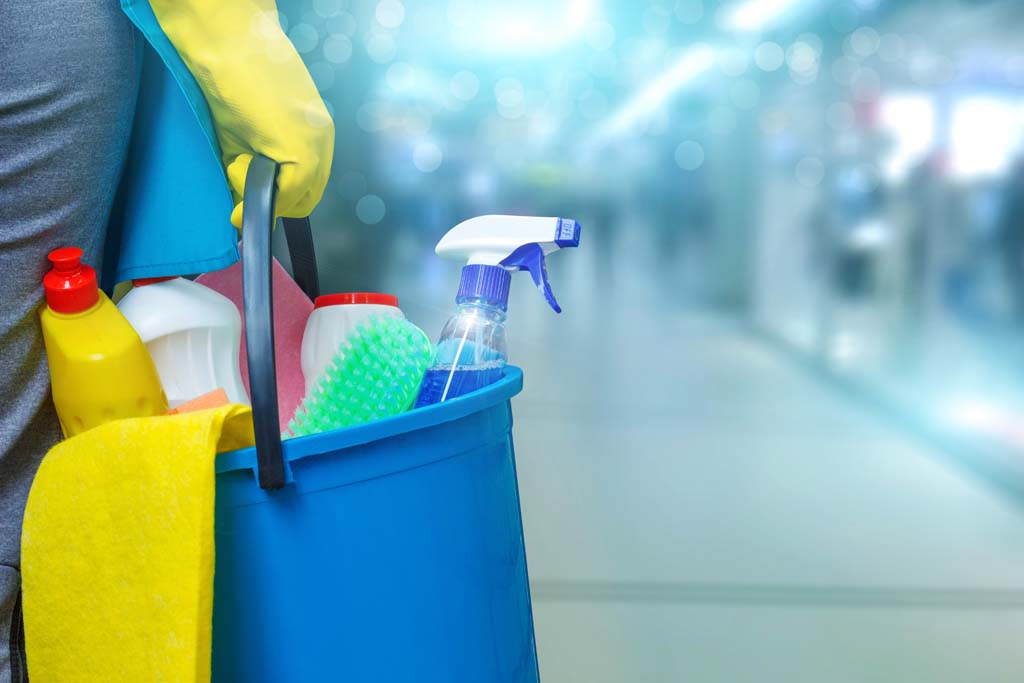The Ultimate Overview to Everyday Cleaning: Exactly How to Scrub the Surfaces, Vacuum Carpets, and Clear Out Any Clutter
Understanding the Requirement for Extensively Disinfecting and Sanitizing Frequently Touched Surface Areas in High-Traffic Locations
In the realm of public health and wellness and safety and security, the thorough sanitation and sanitization of frequently touched surface areas in high-traffic areas stand as critical steps in avoiding the spread of harmful virus. By checking out the various aspects of surface area sanitation, from the threats linked with disregarding cleansing procedures to the reliable approaches that can be used, a more clear understanding emerges of the vital duty these techniques play in securing public health and wellness.
Significance of Surface Disinfection
Highlighting the extensive disinfection of high-traffic surface areas is important in maintaining a sanitary atmosphere and preventing the spread of unsafe microorganisms. High-touch surfaces such as door takes care of, light buttons, elevator switches, and kitchen counters act as breeding premises for bacteria and infections. Regular sanitation of these surfaces is essential to reduce the risk of contamination and transmission of health problems.
By executing a robust disinfection method, organizations and companies can create a more secure environment for site visitors, employees, and customers. Correct surface area sanitation not just minimizes the spread of transmittable illness yet additionally imparts confidence in the sanitation and safety and security of the premises. This positive technique shows a commitment to wellness and wellness, which is particularly essential in high-traffic locations where the likelihood of direct exposure to virus is enhanced.
Moreover, surface disinfection plays an important function in total infection control methods. Incorporated with hand health practices, using masks, and preserving physical distancing, complete disinfection of high-touch surfaces forms a comprehensive defense versus the transmission of hazardous bacteria. Prioritizing surface disinfection is a crucial component of a holistic approach to health and wellness in shared spaces.
Dangers of Ignoring Cleansing Practices
Disregarding thorough disinfection of high-traffic surface areas dramatically enhances the risk of viral and bacterial contamination, posturing a significant danger to the health and wellness of people often visiting these areas. Failure to carry out correct cleansing methods can result in the buildup and spread of dangerous microorganisms, including bacteria and infections, on often touched surfaces such as doorknobs, hand rails, elevator switches, and kitchen counters.

In addition, overlooking the significance of extensive cleaning not only compromises the health of individuals yet likewise weakens efforts to maintain a sanitary and tidy setting. It is important to recognize the value of appropriate sanitation protocols in avoiding the spread of infections and guarding public health and wellness.
Reliable Disinfection Methods
To keep optimum sanitation and minimize the danger of contamination on high-traffic surfaces, using reliable disinfection approaches is crucial. One of the most reliable and usual sanitation approaches is using chemical anti-bacterials.
An additional effective method is the use of UV-C light. UV-C light has been shown to be reliable in eliminating a vast selection of microbes by interrupting their DNA framework, therefore avoiding them from duplicating. Nevertheless, it is vital to utilize UV-C light effectively, ensuring that the correct strength and direct exposure time are put on achieve the desired sanitation outcomes.
In addition, employing vapor cleansing as a disinfection approach can be highly reliable, particularly on surface areas that are heat-resistant. Heavy steam can pass through permeable surfaces and eliminate germs, infections, and other virus successfully. When utilizing steam cleansing, it is important to make certain that the surface gets to the needed temperature level for a sufficient quantity of time to guarantee appropriate disinfection.
Effect On Public Wellness
The upkeep of high requirements of tidiness and sanitation on high-traffic surface areas plays a critical function in securing public health and wellness. Frequently touched surfaces in locations with high footfall, such as doorknobs, hand rails, elevator switches, and washroom centers, function as breeding grounds for unsafe virus. Stopping working to sufficiently sanitize these surfaces can cause the quick spread of transmittable conditions within areas. By carrying out comprehensive disinfection methods, the danger of transmission of infections, germs, and various other bacteria can be considerably decreased.
Reliable sanitation methods not just secure individuals from falling sick yet likewise add to the general health of culture. Public wellness authorities highlight the significance of maintaining tidy settings to avoid outbreaks and include the spread of diseases. In high-traffic locations like flight terminals, colleges, healthcare facilities, and public transport systems, the influence of rigorous disinfection measures can visit not be downplayed. Prioritizing the sanitization of often touched surfaces is a proactive method to promoting public wellness and boosting click to find out more the safety of individuals in common areas.
Carrying Out Routine Cleaning Procedures
Quickly setting up and adhering to a regular timetable of cleaning procedures is paramount for preserving the cleanliness and safety of high-traffic surface areas. Routine cleansing protocols are crucial in stopping the accumulation of bacteria and pathogens on frequently touched surfaces, specifically in locations with high foot web traffic. By executing a methodical strategy to cleansing, organizations can effectively decrease the threat of disease transmission and produce a healthier atmosphere for staff members, customers, and the public.
To develop a reliable cleaning schedule, it is vital to recognize high-traffic areas that need frequent interest. These locations might include doorknobs, handrails, elevator switches, restroom centers, and shared equipment. Carrying out a regular cleaning routine that targets these surface areas multiple times a day can dramatically lower the spread of hazardous germs and infections.
In addition, using appropriate cleaning agents and disinfectants is essential to making sure that surface areas are extensively sanitized. Regular training of cleaning team on correct cleaning techniques and the significance of adherence to the cleaning schedule is also vital in preserving a sanitary atmosphere. By prioritizing constant cleaning this content protocols, organizations can promote the health and health of people that communicate with these high-traffic surfaces.

Conclusion
To conclude, it is vital to focus on comprehensive disinfection and sanitization of often touched surface areas in high-traffic locations to avoid the spread of hazardous microorganisms and preserve public health and wellness. Ignoring proper cleaning practices can increase the risk of contamination and transmission of diseases. By implementing normal cleansing methods and making use of reliable sanitation techniques, we can produce a much safer atmosphere for everybody (Vacuum Carpets). It is imperative to identify the value of keeping tidy surface areas in high-traffic areas to ensure the well-being of the area.
In the world of public health and wellness and safety, the careful disinfection and sanitization of regularly touched surfaces in high-traffic locations stand as critical actions in protecting against the spread of dangerous pathogens. By discovering the numerous aspects of surface area disinfection, from the threats connected with disregarding cleansing procedures to the effective techniques that can be employed, a clearer understanding arises of the important role these techniques play in protecting public wellness.Additionally, using steam cleaning as a disinfection technique can be highly efficient, specifically on surfaces that are heat-resistant. When making use of steam cleansing, it is crucial to ensure that the surface gets to the called for temperature for an adequate amount of time to assure correct disinfection.
In final thought, it is crucial to prioritize complete disinfection and sanitization of often touched surface areas in high-traffic locations to prevent the spread of damaging virus and maintain public wellness.